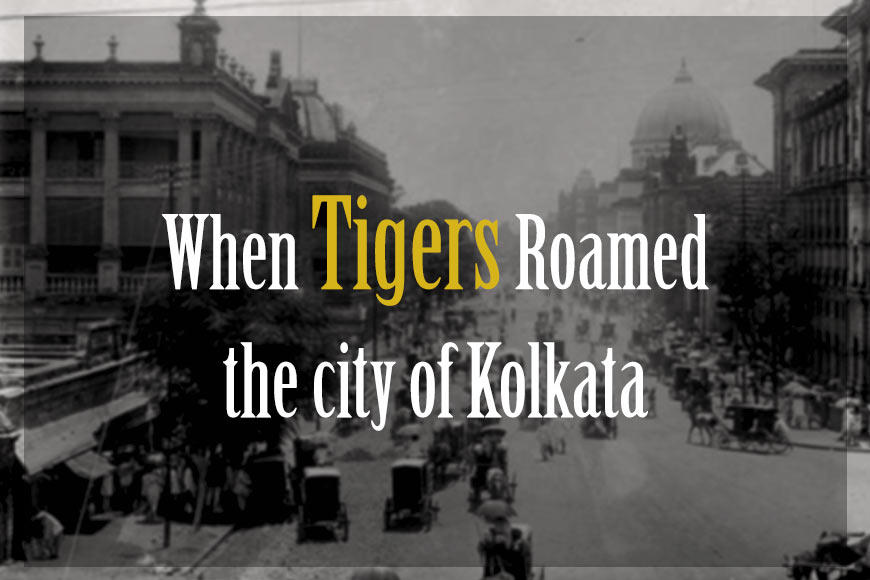When tigers roamed the streets of Kolkata

“Interposed between the sea and the plains of Bengal lies an immense archipelago of islands…. There are no borders here to divide fresh water from salt, river from sea. The tides reach as far as three hundred kilometers inland and everyday thousands of acres of forest disappear underwater only to reemerge hours later.” -- Amitav Ghosh, The Hungry Tide
The Sundarbans has a unique history, nature and landscape. It is half water and half land. It is a terrain where the process of land making has not yet ceased. It is a place that had been alternately inhabited and deserted. It is perhaps the only place on earth that is threatened at once by cyclones, tidal waves, lack of fresh water, tigers, crocodiles and poisonous snakes. It is a unique tiger-land where the tigers are confirmed man-eaters. The Sundarbans is the largest mangrove forest and the abode of the famous Royal Bengal Tiger. Here the tiger stands at the pinnacle of both the aquatic and the terrestrial food chain.
The history of the reclaiming of the Sundarbans forest is fascinating. At the time of the British East India Company’s rise to power, the Sundarbans forests extended to the vicinity of Calcutta. It is difficult to imagine but a major portion of the metropolis formed an integral part of the Sundarbans where Royal Bengal Tiger roamed freely. A lot of evidence has been found to substantiate this claim. About 150 years ago while digging a pond in the Sealdah area, a large number of Sundari trees(scientifically known as Heritiera fomes, it is a species of mangrove in the family Malvaceae) trunks were found entrenched about 30ft below the ground.
The history of the reclaiming of the Sundarbans forest is fascinating. At the time of the British East India Company’s rise to power, the Sundarbans forests extended to the vicinity of Calcutta. It is difficult to imagine but a major portion of the metropolis formed an integral part of the Sundarbans where Royal Bengal Tiger roamed freely.
In those days, elderly locals related fascinating stories of chancing upon fleeting glances of ‘Dakkhin Rai’ (the mythical tiger who is worshipped as the presiding deity of the Sundarbans) strolling fearlessly in the dense jungles that bordered the developing city of Calcutta. In fact, reports of tiger phobia among the local citizens was elaborately published in journals and newspapers of the era. On July 9, 1825, a detailed news report about tigers instilling fear among the residents of Kolkata was published in ‘Samachar Darpan’ newspaper. On April 19, 1849, another report was published in ‘Sambad Prabhakar’ about the rising tiger menace in the city. The report said, a seven-month-old girl child was mauled by a wolf in Shimulia area. The very next day, the wolf visited the same area, and this time it carried away a one-and-a-half-year old baby boy. The wolf remained elusive and could not be trapped.
On July 9, 1825, a detailed news report about tigers instilling fear among the residents of Kolkata was published in ‘Samachar Darpan’ newspaper. On April 19, 1849, another report was published in ‘Sambad Prabhakar’ about the rising tiger menace in the city.
In 1819, a news report in ‘Samachar Darpan’ appeared that described how a woman was killed by a tiger in Gouripur area. After killing the victim, the tiger forcefully entered a neighbour’s house. The residents of the house somehow managed to trap the tiger in a room and locked the door from outside. The police was informed, who, with the help of local administrative staff, managed to kill the tiger.
Early British colonizers felled large number of trees at Gangasagar and its vicinity and cleared the area to build settlements in Kolkata. Deprived of their natural habitat, the tigers came closer to human settlements and moved to the fringe areas of the still developing city. That is how tigers could be spotted now and then by people who lived close to the forests of what we call Kolkata today!











